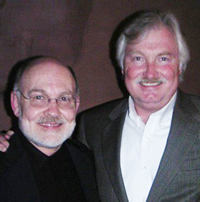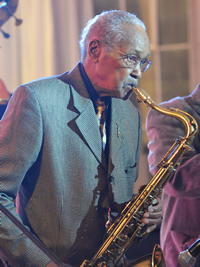Allegro
Reminiscences
Rick Northcutt and Fred Staton
Volume 117, No. 12December, 2017

Richard Northcutt (1943-2017) and brother Mark.
RICK NORTHCUTT
My brother and best friend, Richard Conn Northcutt, 74, an accordionist and a member of Local 802 since 1985, died on Oct. 14. Rick made his first “public appearance” in Norman, Oklahoma on Jan. 12, 1943 to our loving parents William and Betty Northcutt. He was clearly a bright star from the very beginning. As life would have it, he soon had to share center stage with me and our sister Jody.
From an early age, Rick shared his passion for Broadway musicals with those he loved, including his first roommate – me. Rick owned every show tune record that was available, and he would continually play and rotate them. I knew all the words to “West Side Story,” “Flower Drum Song” and many others. After ensuring that Jody and I received a comprehensive and inspiring education in Broadway musical theatre, Rick graduated from Noble High School and was accepted into the University of Oklahoma, where he earned his bachelor’s and master’s degrees in theatre and music.
In his early 20s, following college, Rick accepted a position at the Warwick Hotel in New York City as a night clerk, a position that would allow him to pursue his dream of auditioning and working in musical theatre during the day. After a few scattered successes and setbacks, Cargill Theatre Productions hired Rick to produce and direct touring shows across the country. After paying his dues this way, he was ready to return to Manhattan, which he called home for more than 50 years. Known for his deep and alluring voice, Rick found his niche as a voiceover announcer, music curator and librarian.
Rick immersed himself in New York and Broadway culture, reveling in the theatre, ballets, museums and all that the city had to offer. He had the unique ability to appreciate the beauty of simple and commonplace items, a talent that he used daily as he photographed the city he loved.
While he loved the arts, Rick loved people more. Their stories, after all, were what inspired the larger-than-life tales taken on by actors and singers. His close friends brought him the most contentment and joy. One of them reminisced to me, “Rick had an incredible capacity to care for all of us very personally and thoughtfully. He was a man with integrity, heart and humanity.” Another effused, “Rick made us feel special and important. He leaves a huge void but a wonderful legacy of kindness.” These same qualities made people who had only met him feel as if they had known him a lifetime. Whether he shared his passion for the arts or his love of cooking, we only wish that we had another lifetime to learn more from him.
Rick is survived by myself and my wife Tricia, my sister Jody, and our mother Betty. He also is survived by four nieces and nephews and 12 great-nieces and great-nephews, all of whom he loved dearly and who loved him.
— Mark Northcutt

Fred Staton (1915-2017). Photo: Frederic Sater
FRED STATON
The tenor saxophonist Fred Staton, 102, died peacefully in his sleep in the early morning hours of Oct. 24. He had been a member of Local 802 since 1954. Staton began his career as a saxophonist and bandleader in the 1930s and was well known for his smooth, swing-based approach. Like many of his generation, he emulated Coleman Hawkins and later was deeply influenced by the playing of Ben Webster.
In more recent times he had been an active member of the Harlem Jazz and Blues Band and had participated in several tours with that group, including extended trips to Europe and Russia. He was a well-known figure at Local 802 through his association with the Jazz Foundation of America, and he often performed at the foundation’s Monday night jam sessions at Local 802 and other special events. His younger sister Dakota Staton was an internationally famous vocalist.
Fred Staton was born on Feb. 14, 1915 and grew up in the Lawrenceville section of Pittsburgh. His father was a steelworker at the McConway & Torley steel foundry. Staton was extremely close to his mother, Anna Finch, and often spoke of her as his greatest influence in all things, but especially spiritual matters.
The family eventually moved to the Homewood neighborhood, where Staton had his first experiences with music as a choir singer at a local Baptist church. He later became a member of a youth orchestra, switching to the saxophone from the drums when he realized how prohibitive the latter instrument could be when it came time to pack up after an engagement, especially when members it came time to court female members of the audience who were on their way out the door.
Staton attended Westinghouse High School, where one of his formative experiences occurred alongside the great jazz composer Billy Strayhorn, who visited the school. Staton may have been one of the first musicians to perform Strayhorn’s composition “My Little Brown Book” in a student production with the composer as pianist.
He eventually made the jump to playing with local big bands at Pittsburgh’s Savoy and Stanley theatres, and began to lead his own small groups, playing around Pittsburgh with longer jumps to Atlantic City and points east.
Staton supported himself with a variety of jobs outside of music. During World War II he worked as a First Class Welder at the Drevo Shipyard on Pittsburgh’s Neville Island. His trio, the Three Tempos, which later expanded to a quartet, was very active during the war and later.
In the early 1950s, Staton made the move to New York City where he worked as a waiter and eventually moved up to the position of first maître d’ in a restaurant associated with Lincoln Center’s Vivian Beaumont Theatre. However he continued to perform on his saxophone throughout the New York City area, especially in Harlem.
His association with the Harlem Blues and Jazz Band, under the management of Dr. Al Volmer, began in the early 1970s where he worked alongside Happy Caldwell, Doc Cheatham and Eddie Durham.
He was a beloved figure on the New York City jazz scene and continued to astonish musicians and fans alike, performing eloquently on his instrument into the last three decades of his life. In fact, Staton had still been actively performing this year, even at the age of 102.
A highly spiritual person, he was an active member of Harlem’s Abyssinian Baptism Church.
Fred Staton is survived by his sons Fred Jr., Richard, John and David; daughter-in-laws Diana, Sallie, Barbara and Patricia; grandchildren Richard Jr., Charles Jr., Melinda, John, Denise and Jasmine; cousin Bill, nieces Glenore and Leola Ann; nephew Bill; stepchildren Andre, Harold and their families; and great-grandchildren Naomi, Deborah, Kiara, Ramessess and Semirah. He also cherished his long connection with the former Dorothy Myers and family. In addition, he leaves a host of other relatives and devoted friends. A memorial service is planned for Feb. 12 at Local 802.
When asked in a recent interview to what he attributed his longevity, Staton was quick to respond.
“My longevity?” the saxophonist replied, “The main thing I attribute it to is just two words: spiritual truth.”
